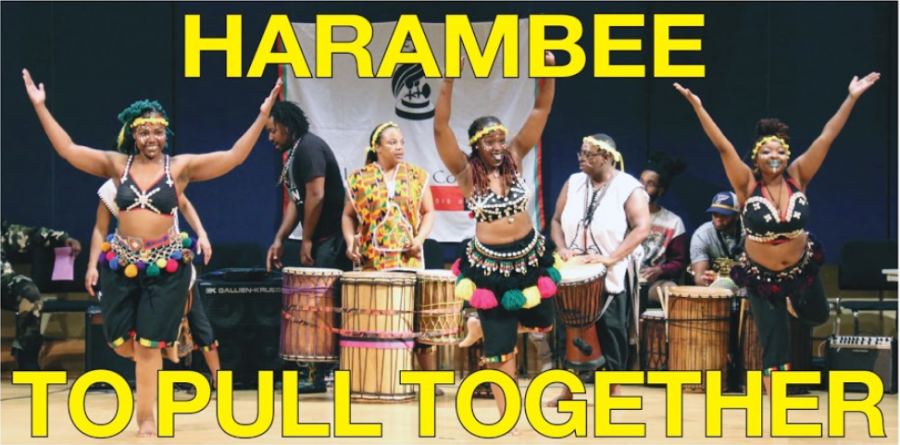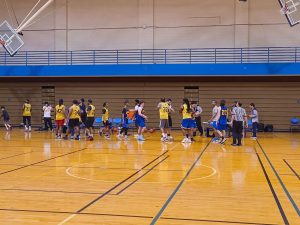NEIU recognizes Black History Month, honors Harambee tradition
February 13, 2020
In Kiswahili, Harambee means “to pull together.” During NEIU’s celebration of Black History Month, the university hosted its annual Harambee event on Feb. 3 inside the Recital Hall. “This is our pull together, Black History Month event,” announced Dr. Sharon Bethea, professor of Counselor Education and coordinator of African and African American Studies. “We are celebrating black life.”
Bethea is one of the original event organizers, which was put together by the Black Heritage Month Committee (BHMC) and the African and African American Studies program. The BHMC consists of chairperson and assistant director at the Angelina Pedroso Center Timothy Mays, along with approximately 15 NEIU students, faculty and staff.
The notion of Harambee–as a community pulling together–is as old as the continent of Africa, but Harambee was formalized by the African American community in 1966 when Kwanzaa was first celebrated.
As for NEIU’s Harambee celebration, it began just three years ago when Bethea proposed that the event take place on the first Monday of February, since Kwanzaa coincides with Winter Break.
According to Bethea, the celebration is an important construct of African American culture because it connects to “African ways of being.” The celebration can also be recognized during weddings and birthdays because the underlying theme brings the community together. Harambee celebrations can last all day, but NEIU’s was around three hours of celebration.
President Gloria J. Gibson took to the stage to welcome everybody to her second Harambee at NEIU. “My discipline is ethnomusicology and African and African American Studies. So when I hear the music and see the musical performances, this takes me back to when I was a faculty member.” Gibson also encouraged the audience to enjoy the evening, let go, relax and learn about African American culture.
Maureen T. Amos, executive director for the Office of Financial Aid, Scholarships and Student Employment proceeded with a Libation Ceremony. “The libation ceremony has been a tradition among African people for literally thousands of years, whereby we ask the blessing and sanction of our ancestors through what we are about to do,” said Amos.
The ritual involved pouring water from a “kikombe cha umoja,” or unity cup, into a plant as a symbolic gesture of reciprocity between the living and deceased. Amos spoke a prayer in Kiswahili as audience members contributed names of their ancestors. “Asante sana,” said Amos at the end of the libation, which means “thank you very much”.
The emcees for the evening were Velshay Stokes, program student adviser for Student Success and Retention and Alexx Brown, NEIU student from the CMTC department.
Mays shared his story with a spoken word poem. At birth, Mays’ doctor said that he would never have a normal functioning brain. 33 years later, Mays proclaimed, “I managed to graduate from high school in 2007. Moved away to college, 2008. Pregnancy scare, 2009. I moved back home, 2010. I gave my life back to God, 2014. The first in my family to receive a college degree, 2016, I received my masters.” He was interrupted with cheers from the audience.
Mays went on, “The biggest lesson I’ve learned is that people love to play the sports analysts, when they are watching from outside the ring.”
The poem took the audience through his battles. “It’s for those in the middle of the fight when people sucker punch them with phrases like, ‘Are you sure you want to do that? I know someone who did that once. Dreams don’t pay no bills, keep all your receipts. Don’t call me when it doesn’t work.’ In case you didn’t know, those words sound awful a lot like one.”
Mays continued with boxing analogies to convey the internal dialogue he used to get through the struggles. “When I feel my most defeated, I drop to my knees and raise my hand to hide it. The people in the crowd cannot determine whether I’m surrendering, or claiming victory. This fight takes both, you can’t have one without the other.”
The poem ended with, “I raise my fists, put my back against the ropes and keep fighting,” as Mays mimed jabbing, slow punches into the imaginary opponent in front of him. He made punching sounds, it slowly faded and the whole room cheered.
Brown came back onstage and added, “For those of you who do not know, Tim is not just the assistant director of Pedroso Center. He is also the assistant director of Black Student Success here at NEIU. So his job is to make sure that we stay here, that others come here and to make sure we graduate with that degree that he was talking about.”
Harambee also included performances by invited guests of the BHMC. All were residents of Chicago with performances varying from spoken words accompanied by bass, sax, flute and percussion in the background, a violin and song performance mashup with the disk jockey and acoustic guitar with an emcee rapping. The final portion consisted of Afro-Puerto Rican live music and dance, followed by African dance and drums which called on the audience to get up on the stage and dance along.
The closing remarks were delivered by Bethea who thanked the African and African American Studies program, Office of the President, Division of Academic Affairs, Angelina Pedroso Center for Diversity and Intercultural Affairs, Division of Student Affairs, the Colleges and NEIU campuses for their support of the event and the entire month of activities.
After the show, the crowd gathered outside of Recital Hall to enjoy African and African American cuisines such as barbecue chicken, Jamaican Jerk chicken, peas, rice, steamed cabbage, collard greens and peach cobbler.
Mays commented about this year’s Harambee while serving food. “I thought it was great. I thought it was a perfect way to kick off the month. And I hope that we continue to celebrate the same way, as we continue to move forward.”
Sylvia Daniels is the Director of Development and also a member of the BHMC. She commented, “This is a good way to celebrate African Americans and the entire African diaspora. But it’s a great opportunity for all our students to be able to come and experience and expand and learn about another culture. And all that does is build strength in all of us being one community.”
“We’re happy to see that [Harambee] has grown into an annual event and one of the staple events of Black History Month,” said Brown who will be hosting and moderating many of the events for Black History Month.
“The turnout is getting bigger and bigger. So our hope is soon we will come out of Recital Hall and maybe move to the auditorium because we can see that the space is filling up and we are getting more performers,” continued Brown. “It’s amazing that people come out, not just black people of African American descent, but for people of all cultures come out to support and show love and celebrate and have fun in that space. So it’s amazing and I’m excited to see the growth in the coming years.”
Harambee was a successful celebration this year containing common themes like dancing, music, eating, celebrating, libation and lectures. Eric Winslow, president of the NEIU Black Caucus commented, “The event was spectacular. I really enjoyed it. The crowd was amazing, the performances were uplifting and I felt connected to my roots as the events went on.”
A sense of community and camaraderie appeared to be the goal when asked what Bethea hoped the audience and NEIU community would get out of NEIU’s celebration of Harambee. “I think more of an understanding of the beauty of African descended people and people from the black diaspora. Coming together of community and a feeling of community. Just having a good time, having fun together, joyous and just kind of seeing that depiction of African, African American and Afro Diasporic celebration in school during Black History Month.”
“We are getting more intentional. Like last year, we had a band from Mexico. This year, they were from Puerto Rico. I think for next year we’re going to look for Afro-European and Aboriginal Australians,” said Bethea.
Black History Month officially began on Jan. 31 with NEIU celebrations kicking off at the Carruthers Center for Inner City Studies (CCICS) campus with a tribute to Carter G. Woodson, known as the father of Black History Month.
The next event, similar to Harambee, but will focus on performances by the NEIU community is on Feb. 13 at 6 p.m. in Alumni Hall. “It’s called the Africana Arcade and it will be celebrating community, culture and fun. It’s gonna be doing it through games, dancing, experiences and music. Just a fun community gathering, kind of like this, but on a more intimate scale with games included,” said Brown. “Open to the NEIU community. Anyone can come through.”









